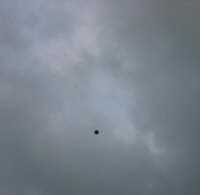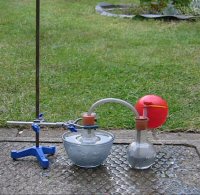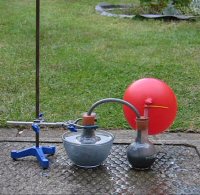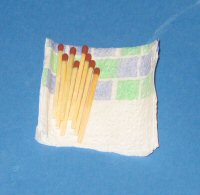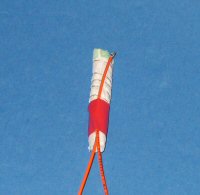Hydrogen Production
Hydrogen, with its single electron and proton, is the smallest and most basic element in the universe, yet I think it's one of the most interesting. With the exception of the hydrogen isotopes (heavy hydrogen and super heavy hydrogen), it doesn't even have a neutron.
To obtain hydrogen I've opted to use HCl (hydrochloric acid) and Al (aluminium), which when combined will react to produce an aluminium chloride salt and hydrogen gas.
2Al(s) + 6HCl(aq) -> 2AlCl3(aq) + 3H2(g)
The aluminium chloride quickly hydrolyses in the water to form an acidic solution consisting of aluminium trichloride 6-water cations and chlorine anions.
AlCl3(s) + 6H2O -> [Al(H2O)6]3+(aq) + 3Cl-(aq)
The aluminium trichloride 6-water ([Al(H2O)6]3+) cation is so highly charged that it polarizes the water molecules oxygen atom away from the hydrogen atoms.
[Al(H2O)6]3+(aq) + H2O(l) -> [Al(H2O)5OH]2+(aq) + H3O+(aq)
Somewhat less importantly, but never the less still involved, the aluminium oxide layer will also react with the hydrochloric acid to form aluminium chloride and water.
Al2O3(s) + 6HCl(aq) -> 2AlCl3(aq) + 3H2O(l)
Generating hydrogen is reletivly safe as long as the stored hydrogen doesn't mix with too much oxygen, which could result in an explosive combination. Hydrogen and oxygen explosions are never a good thing, but when you add to them glass and acid they are surely something you want to avoid. Especially when you consider that it only takes a small amount of static, for example from a balloon, to set one off. Although I should say that I've been mixing hydrogen and oxygen in various setups and have not yet experienced an unexpected explosion. But then again, I still take the necessary safety precautions.
The following 2 images give a general idea of the setup I'm using. Although it should be noted that I tend to change the setup depending on the experiment being performed.

|

|
The left hand flask (the reaction chamber) holds the hydrochloric acid and the aluminium which react to form the hydrogen. This hydrogen then travels through the PVC tube to the right hand flask (the disolving chamber). The right hand flask contains water. The water serves 3 purposes, the first purpose is to exclude some of the oxygen from the system, the second is to disolve any hydrogen chloride that has travelled through the system with the hydrogen, and the third is to stop the steam geneated by the reaction from entering the balloon.
The reaction between HCl and Al can generate a fair bit of heat depending on the quantities used. For this reason it is sometimes necessary to use a cooling bath (water and ice cubes) with the reaction chamber. This cooling bath isn't shown in the above images, but it is usually visible in the results.
Floating Hydrogen
Filling a balloon with hydrogen and then letting it float away is actually quite satisfying. On a calm day with clear skies the balloon can float straight up and completely out of sight.At the moment I'm using standard party balloons. Although they're cheap they do have the disadvantage of always trying to contract when inflated. This puts pressure on the stored hydrogen which causes it to slowly leak out of the balloon. A better choice of balloon would be the non-elastic foil type which are usually used with helium.
The following video stills show the reaction taking place. In the second image you can see the reaction chamber boiling violently and the aluminium foil being pushed through the PVC tubing. Sometimes the foil can block the tube, which results in the rubber bung being blown out.
Since I started this page I've bought some helium balloons. They hold the hydrogen for much longer and inflate to a lager size. The result is that the balloons can go straight up out of sight.
Burning Hydrogen
To set fire to the hydrogen filled balloons I'm using a homemade electronic ignitor.The ignitor consists of 8 matches wrapped up in a small piece of kitchen roll which then has a thin piece of wire wrapped around it. Both ends of the thin wire are connected to a bench top power supply via 2 thick wires. The bench top power supply is a variable low voltage (0V to 15V) high current (35A) supply. When the supply is switched on the thin piece of wire glows red hot which causes the kitchen roll to start smoldering. The smoldering kitchen roll then causes the matches to ignite. To ensure a large flame I often soak the kitchen roll with lighter fluid. Using an electronic ignitor, as opposed to a chicken stick, allows the balloon to be ignited from a safe distance.
The following images are captured from video.
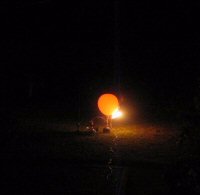 |
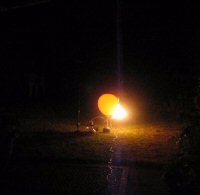 |
 |
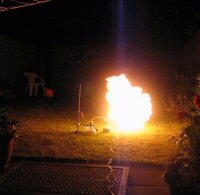 |
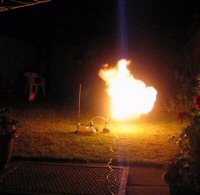 |
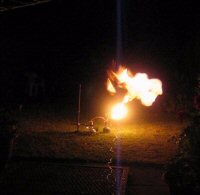 |
 |
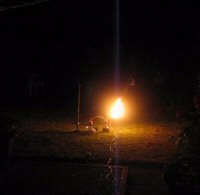 |
 |
 |
 |
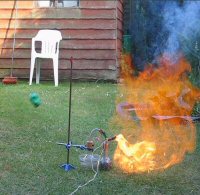 |
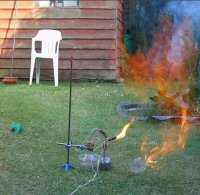 |
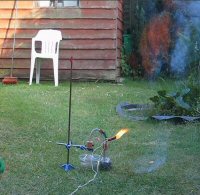 |
 |
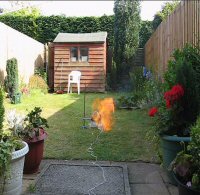 |
 |
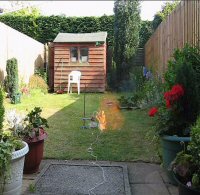 |
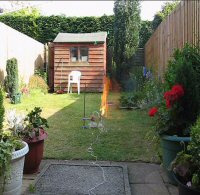 |
 |
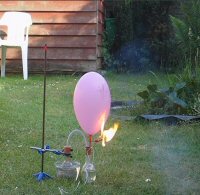 |
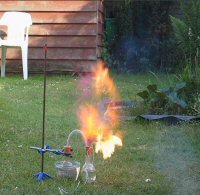 |
 |
 |
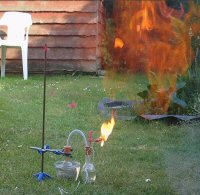 |
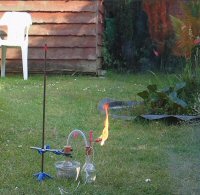 |
| Home |
